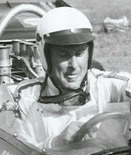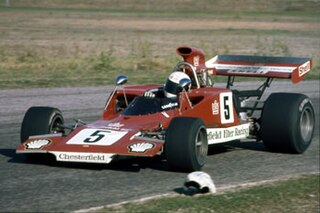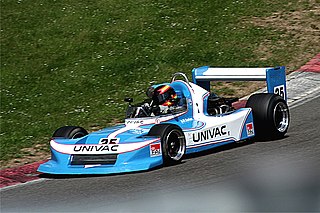Related Research Articles

Gunnar Axel Arvid Nilsson was a Swedish racing driver, who competed in Formula One from 1976 to 1977. Nilsson won the 1977 Belgian Grand Prix with Lotus.

Graham Peter McRae was a racing driver from New Zealand.
Connew Racing Team, commonly known as Connew, was a short lived British Formula One constructor. Founded in 1971 by Peter Connew, the team constructed a single car, the PC1. The first monococque had to be aborted due to a change in regulations and the second tub was known as PC2. However, record books show the car driven by Migault and others as PC1. The intent was to compete in the Formula One World Championship in 1972, but a lack of financial and technical resources meant that the car only managed to start in one championship race, the 1972 Austrian Grand Prix, with French driver François Migault at the wheel. Following the Austrian race, the car competed in a handful of non-championship races before being converted to meet Formula 5000 specifications for the 1973 season. The chassis was damaged beyond repair during the season finale at Brands Hatch and the team closed.

Formula 5000 was an open wheel, single seater auto-racing formula that ran in different series in various regions around the world from 1968 to 1982. It was originally intended as a low-cost series aimed at open-wheel racing cars that no longer fit into any particular formula. The '5000' denomination comes from the maximum 5.0 litre engine capacity allowed in the cars, although many cars ran with smaller engines. Manufacturers included McLaren, Eagle, March, Lola, Lotus, Elfin, Matich and Chevron.

Formula Atlantic is a specification of open-wheel racing car developed in the 1970s. It was used in professional racing through the IMSA Atlantic Championship until 2009 and is currently primarily used in amateur racing through Sports Car Club of America Formula Atlantic.
The March 87B was an open-wheel formula race car, designed, developed and built by British manufacturer March Engineering, for Formula 3000 racing categories, in 1987.

The Lotus 69 was an open-wheel formula racing car developed by Lotus in 1969 for use in Formula 2, Formula 3, and Formula Ford.
Colchester Racing Developments produced Merlyn racing cars from 1960 to 1979. The company was founded by Clive Maskrey, Selwyn Hayward and continued by Hayward's brother, Clive. When the manufacture of Merlyn racing cars stopped, Clive Hayward continued to manufacture Merlyn parts as CRD Tool and Engineering Ltd. This company stopped trading in November 2015. Still, Clive Hayward continues to run Colchester Racing Developments, manufacturing Merlyn components and carrying out chassis repairs.
Royale Race Cars was a British constructor of race cars in the 20th century. The company produced single seaters as well as sports cars.

The Brabham BT21 was an open-wheel formula racing car, designed, developed, and built by Brabham in large numbers in 1966 and delivered to private individuals; 110 vehicles were manufactured.
The Cooper T88 was an open-wheel formula racing car, designed, developed and built by British manufacturer and constructor Cooper, for the SCCA's Formula C category, in 1968. It was closely based on the Cooper T86 Formula One car. It was colloquially referred to as the Cooper-BRM, due to the 1.0 L (61 cu in) BRM four-cylinder engine that powered it. It was driven by Peter Rehl, and was later converted to a Formula B car, where it was powered by a 1.6 L (98 cu in) naturally-aspirated Ford Twin Cam four-cylinder engine, tuned by Cosworth, to produce between 140–150 hp (100–110 kW). Rehl finished the 1968 season in fourth place, scoring 24 points.

The Lola T300 was an open-wheel formula race car, designed, developed and built by Lola Cars, for Formula 5000 racing, in 1971.

The McLaren M22 is an open-wheel race car, designed and developed by McLaren, to compete in Formula 5000 racing in 1972. Like it predecessors, The McLaren M22 was manufactured in large numbers. Built close to the weight limit, it was very light and was powered by a 500+ hp Chevrolet V8 engine. The cars were not actually manufactured by McLaren itself, but by the British racing car manufacturer Trojan, as with previous models. This would turn out to be the last Trojan-built McLaren F5000 car.

The March 782 was an open-wheel Formula 2 car, designed, developed and built by British manufacturer March Engineering in 1978. The 782 chassis was very competitive, and March dominated the season with their 782 chassis, and it was a clean-sweep; winning 11 out of the 12 races, and Bruno Giacomelli winning the championship, with 78 points. Marc Surer finished second-place in the championship as runner-up, with 48 points ; also driving a 782 chassis. It saw continued used until the end of 1981, with Alberto Colombo winning at Hockenheim in 1980 with a two-year-old 782 chassis.
The Chevron B20 is an open-wheel formula racing car, designed, developed and built by British manufacturer Chevron Cars, for Formula Two, Formula Atlantic, and Formula Three racing, in 1972. It was an evolution of the previous B18. It was powered by the 1.8 L (110 cu in) Ford-Cosworth FVA four-cylinder engine, making 235 hp (175 kW).
The Chevron B6 is a lightweight sports racing car, designed, developed and built by British manufacturer Chevron Cars, in 1967. Only 7 cars were built, which makes it very rare. Over its career, spanning 8 years, it won a total of 15 races, plus 4 additional class wins, clinched 1 pole position, and scored 30 total podium finishes.

The March 712 was an open-wheel Formula 2 race car, designed, developed and built by British manufacturer March, in 1971. It was very successful, with Swede Ronnie Peterson winning the 1971 European F2 Championship season in a Cosworth-powered 712. Peterson won 5 races that season, and took 6 podium finishes, as well as taking 7 pole positions, and 5 fastest laps. Peterson finished the championship in first place, with 54 points. Austrian Dieter Quester, also driving a March 712, finished the championship in third place, with 31 points, driving a BMW-powered 712. The 712 was powered by either a Ford-Cosworth FVA, or a BMW M12/7; which were both naturally-aspirated 1.6 L (98 cu in) four-cylinder engines. A sister variant of the car, called the March 71B, was the Formula B (Atlantic) version of the car.
The Dallara F3 cars are open-wheel formula racing car, designed, developed and built by Italian manufacturer Dallara, for Formula Three categories.

The March 742 is an open-wheel race car, designed, developed and built by British manufacturer March Engineering, and constructed to Formula Two regulations, and introduced for the 1974 championship. Its Formula Atlantic equivalent, used in the Atlantic Championship, known as the March 74B, was based on the 742.
The March 72A, also designated as the March 722A, and also known as the March 725, was an open-wheel formula racing car, designed, developed, and built by British manufacturer and constructor, March Engineering, for Formula 5000 racing, in 1972. It competed in both the European and SCCA U.S. F5000 championships, being driven by Canadian John Cannon. It was itself based on a March 722 Formula Two chassis, and was powered by a powerful 5.0 L (310 cu in) Oldsmobile V8 engine.
References
- ↑ "March 722 Cosworth BDG, 1972 [Auta5P ID:8734 EN]". auta5p.eu.
- ↑ "[SOLD] - 1972 March 722 Formula Atlantic". march722.wordpress.com.
- ↑ Brown, Allen. "March 722 (Formula B) car-by-car histories". OldRacingCars.com.
- ↑ Brown, Allen. "March 722 (Formula Atlantic) car-by-car histories". OldRacingCars.com.
- ↑ "1972 March 722 technical and mechanical specifications". conceptcarz.com.
- ↑ "1972 March 722 Formula Atlantic". racecarsdirect.com.